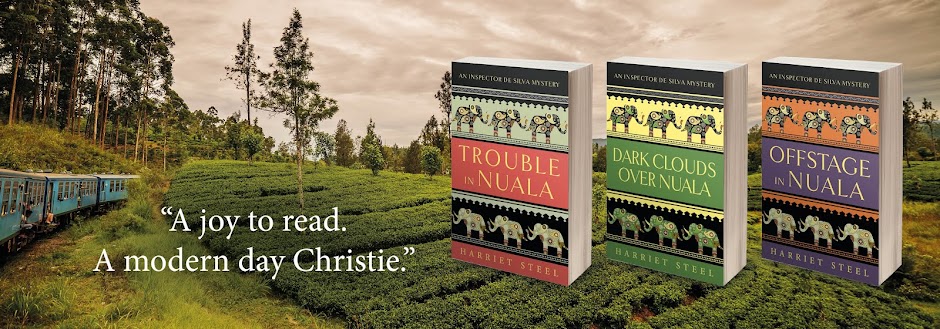I’m delighted to welcome Beth
Webb, to my blog. Among other things, Beth is the critically acclaimed author of many books for children,
teens and adults. Beth, do tell readers something about yourself and what
decided you to be a writer.
My Dad always wanted to be a writer and he used to make up stories for
me when I was little. He taught me that stories came out of heads as well as
books. Before I went to school I used to scribble on bits of paper and sew them
between cardboard covers to make books, I guess the urge to be an author was
with me even then!
My first published piece was in a pop magazine when I was about 15. I
met a brilliant blues group and wrote about them and was paid three guineas
(about £25 in todays money).
I didn’t know what I wanted to do after school – there was no advice on
‘how to be a writer’ in those days and my English teacher put me off being a
journalist, so I read sociology and psychology. After uni I travelled around
Europe, and lived with a hippie commune in a houseboat in Amsterdam and a
mediaeval Bavarian castle, I also stayed for a while in an ex-leprosy hospital,
then an attic in Rotterdam. I earned money cooking, cleaning, teaching English
and selling paintings. I still love the Dutch language and people.
When I was about 27 I thought I ought to grow up and come home, so I
worked for an independent radio station, then a national newspaper where I met
my husband. I started writing stories for my four kids as Dad had done for me,
and in 1993 I published my first children’s novel.
In 2000 I did an MA in Creative Writing at Bath
Spa, then I became a tutor for the Open
College
Usually things people say get me thinking. For example, with Star
Dancer, I met a lady at a picnic who wanted to be a minister, but her church
didn’t approve or women priests. I began to think about all the people who
can’t be who they are meant to be because of colour, creed, sex or disability –
and Star Dancer began to grow.
When I get an idea I write it down, then from time to time I flip back
through my notebooks. I’m often amazed at some of the ideas I’ve come up with. They
aren’t bad.
Who are the authors who have most
influenced you?
Where do I begin? Ursula le Guin, Susan Cooper, Terry Pratchett, Philip
Reeve, David Almond, Philip Gross. I couldn’t have written my historical work without the
inimitable Prof Ron Hutton and every collector of fairy stories and folk tales.
Do you base any of your
characters on real people?
How do you develop your ideas into
books?
How do you write? Do you have
routines and rituals you like to stick to?
I’m at my computer every day from 8 or 9 am, usually with tea and
breakfast next to the mouse, and I work until about 4, when my brain seizes up,
then I go for a long walk to think through what I’m going to do next.
The Star Dancer quartet, set in the Iron Age, was originally written
for teenagers but it crossed over into the adult market. Did that surprise you?
You also write for young children
with your entertaining series about Fleabag the cat.
(Beth takes a deep breath…) I could go on far ages about this. How long
have you got? In short, children like to be entertained and to explore emotions
and the difficulties of life from a safe place they can return to when they
close the book.
YA readers like to be thrown in the deep end with all the rolling,
terrifying dangers of high action writing with fantasy creatures like dragons
and vampires, danger, death and sex (sex is a sticky question for another day).
Teen readers know the world is a deadly place, they are longing to find
a path through – however risky. Watch them play computer games and you’ll see
what I mean. Teens don’t like being protected.
Apart from writing, you work with
schoolchildren on a variety of projects. Can you tell me more about that?
I run workshops and courses for young writers at schools up and down
the country, and especially at a place called Kilve Court Somerset Glastonbury
So what’s next? Will there be new
stories for Fleabag and Tegen?
Fleabag is getting a BIG makeover
- Fleabag and the Fire cat is being revamped this winter for publication
next year. I’m also planning a prequel. As for Tegen? I’ve been asked if I’ll
write what happens to her daughter Gilda, growing up in ancient Ireland, and
others have asked for the stories of Sabrina and Owein – and how their
ancestors become – well, it’d be a spoiler if I told you who. But I’m not sure.
I’ll see what my publisher says when I’ve finished everything else I have in
hand at the moment.
Beth, thank you so much for
coming, it’s been such a pleasure talking to you.
Find out more about Beth at her
website, www.bethwebb.co.uk. It
includes her top tips on writing as well as a ‘contact me’ button if anyone has
more questions. She’s also on Twitter as @bethwebbauthor and https://www.facebook.com/bethwebbauthor.
Below: one of Beth's illustrations for Fleabag and the Ring of Fire.
Below: one of Beth's illustrations for Fleabag and the Ring of Fire.


















